Creamed Salmon and Peas
A great way to make salmon an affordable family meal
This is the sort of meal that helped stretch a family’s food dollar when I was young. I am a boomer. I think there’s a general perception that the 1950s were years of plenty. They were not. People worked very hard for not a lot of money. But the parents of the 50s were born at the tail end of the depression and the 1950s looked pretty good to them. Still, they grew up knowing how to make the most of a buck and they spent what they had wisely. Creamed salmon and peas served on toast or crackers is a good example of a thrifty weekday meal.
Salmon is always near the top of any list of healthy proteins. Creamed salmon and peas delivers the nutrition of salmon at an affordable price. That’s why I decided to bring one of my mother’s favorite meals back to my dinner table. And I’m glad I did.
I am calling this dish creamed salmon and peas because that is what I am used to it being called. But it is not a sauce made with dairy. The sauce is a basic white sauce made with butter and flour. And if you have never made a white sauce or have tried but not quite got it right, we are going to show you how.
We are going to make a roux
For this recipe we are going to make a roux, pronounced ROO. Making a roux is a method used to thicken a sauce or gravy. It is the basis of our white “cream” sauce.
Learning to make a roux can open up a whole new range of cooking options to you. Some would claim they are hard to make, but as long as you take your time cooking the roux and adding the liquid, it will be perfect every time. It is basically a quick 2 step process.
We are also going to poach the salmon
Have you ever poached? I think the most known ingredient to be served “poached” is an egg. Most people at one point or another has had or seen a poached egg.
To poach you use a warm water “bath” to slowly cook an ingredient. Poaching keeps the ingredient in tact and gently cooks it through.
We are poaching the salmon for a couple of reasons. First so we can retain the salmon’s flavor and texture when cooking it, and also we are going to use the poaching water to make our cream sauce after making our roux. It will bring more salmon flavor to the dish.
It’s easy and quick
Don’t let the fancy words kid you. This meal is quick and easy to make. The whole recipe only takes about 30 minutes.
Here’s what YOU WILL NEED:
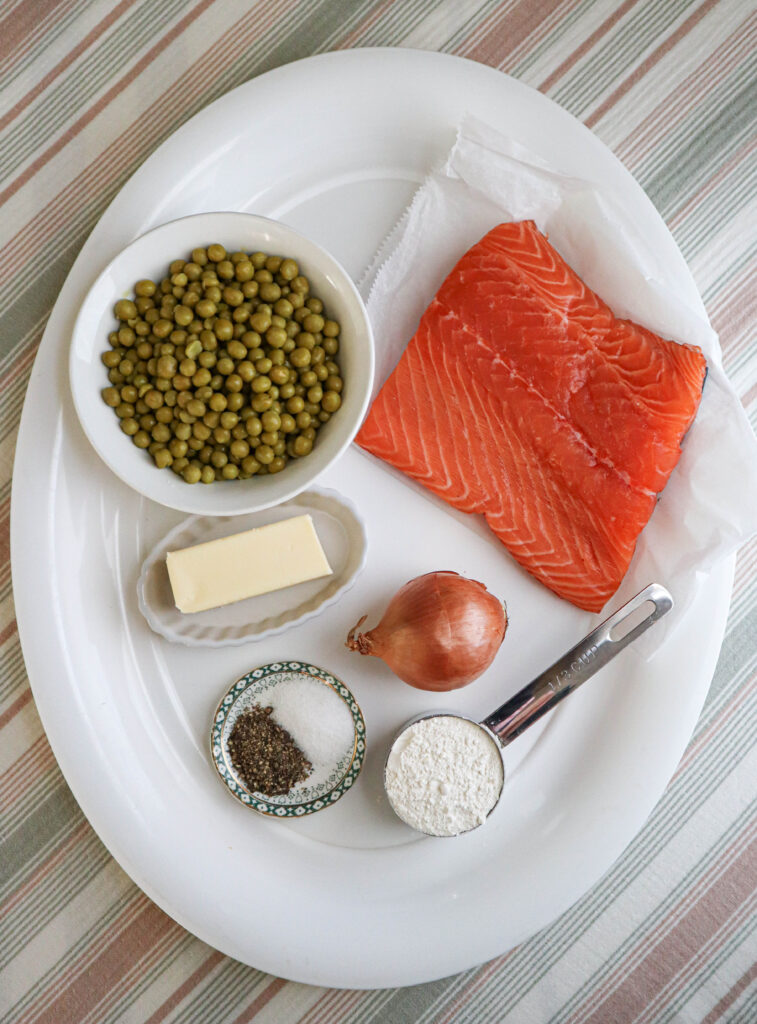
| 1 + 1/2 pound salmon |
| 1 small yellow onion |
| 5 tablespoons of butter |
| 1/3 cup white flour |
| one teaspoon each of salt and pepper |
| one 14.5 ounce can of peas or 1+1/3 cup frozen peas |
Salmon
Any recipe I have seen lately for creamed salmon and peas has called for canned salmon. It’s certainly not cheaper to buy canned salmon and the quality of the fish may not be as good as a piece you buy at the seafood department. My bet would be the salmon processed in cans is not the best caught that day.
It is only going to take us 15 minutes to poach our salmon and we are going to use the same skillet to make the rest of the dish. So it’s still a one pan meal. Plus, when we poach our salmon we are going to get a seafood broth to make our dairy free cream sauce. It’s a win, win.
Peas
As you can see on the list of ingredients, you can use canned or frozen peas. Whichever you like. Heck you can use fresh if you want to. I don’t see fresh peas much in the grocery store these day. But that would be delicious alternative. A little more time consuming but delicious. We used canned peas in the batch you see pictured in this post. I like fresh peas, frozen peas and canned. In certain recipes I am used to frozen or canned, so I use what I have become accustomed to. It’s just personal preference.
Onion
We are going to cut a small onion into quarters and add them to the water when we poach the salmon. We will strain them out of the water when we are done poaching. We are only using onion to give the seafood broth a touch of onion flavor.
This is WHAT TO DO:
Poach the salmon
Why poach?
First we are going to poach the salmon and make our salmon broth. Poaching couldn’t be easier. Basically it’s cooking slowly in a hot water bath using a skillet.
Why are we poaching? Fish cooks quickly no matter how you are cooking it. It’s also pretty delicate. If we were to boil the salmon the action of the water is going to be tossing it around and it will start falling apart and loosing texture, volume and taste in the process. Frying would add oil to the salmon and baking can dry the salmon out. None of that happens with poaching. Our salmon will be tender, moist and delicious with it’s true flavor.
How to poach
Put your salmon in a skillet, skin side down, then add enough water to cover the salmon. Peel and cut a small onion in quarters and add it to the water.
You can warm up the water on medium high heat, but as soon as you see bubbles on the bottom of the skillet turn the heat down to medium or lower. We are not boiling or even simmering the salmon, we are poaching. You don’t want to see any bubbles rising and breaking open on the surface of the water.
It should take about 15 minutes to poach your salmon. You will know it is done when the salmon splits open and the meat is all the same light color when you look into the places that have split. Don’t be concerned about the onion breaking open or the bits of white that will float to the top.
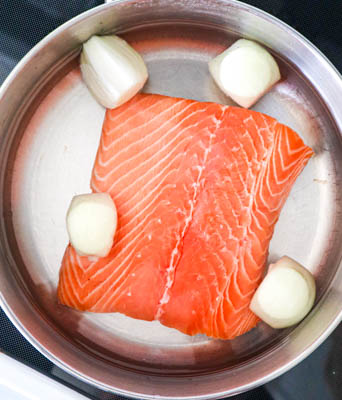
Put the salmon skin side down in a skillet, cover with water, add a small quartered onion.
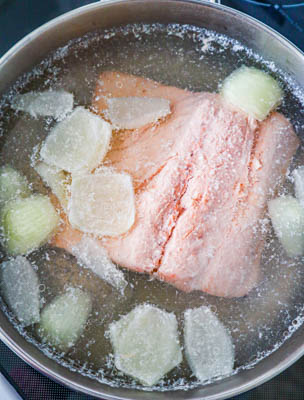
Keep the water from getting to a boil or even a simmer. It will take about 15 minutes to crack open and turn light pink in color. That’s how you know it is done.
Flake the salmon and remove the skin
Take the cooked salmon from the water with a spatula and put it on a plate. The salmon is very tender and just about ready to fall apart. To flake it use two forks and gently pull the meat of the fish away from the skin. It’s a quick and easy process.
Strain the water (which is now a salmon broth) through a strainer or colander into a bowl or large measuring cup. You will probably have about 4 cups. You’re straining it just to get the onions out. We are not using the onion in our dish, we put them in to flavor the broth a bit. You will also catch some of the white specs of fish that rose to the top. You don’t need to get those specs out. It’s part of the broth.
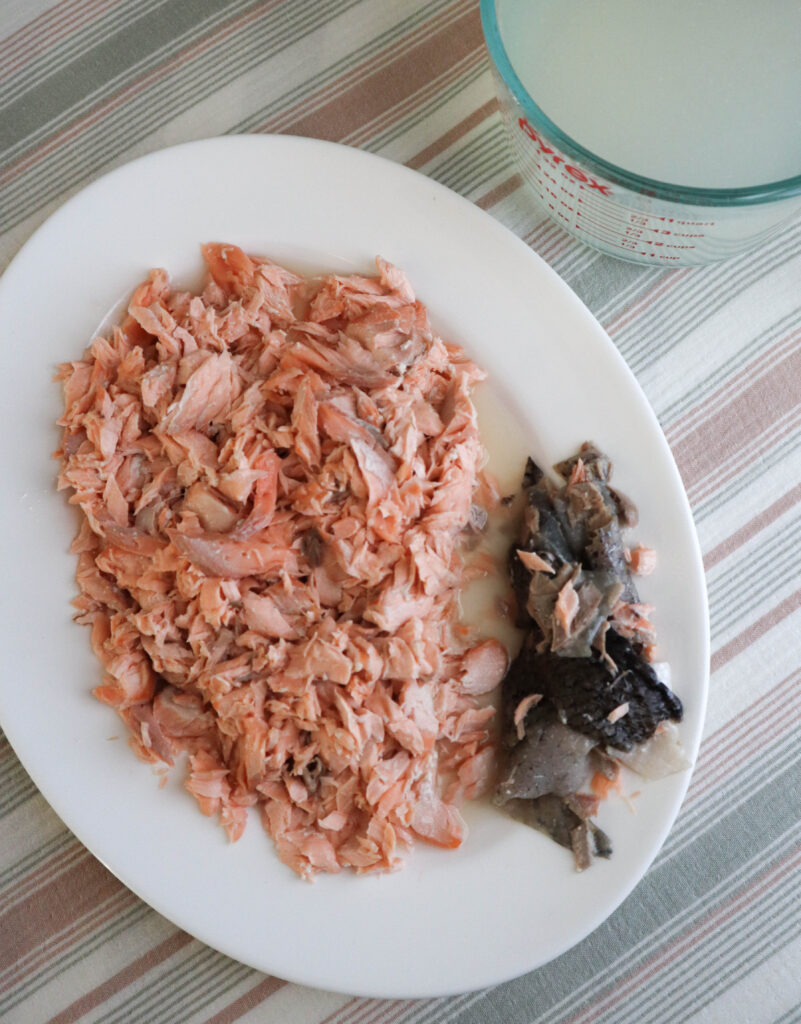
This is what the poached salmon will look like when you flake it. At the bottom of the plate is the skin that has been removed. You don’t need to pull the skin off. While you are flaking the fish it will separate from the skin.
In the top right corner is the strained salmon broth (poaching water) from the skillet. I have 4 cups of broth and it was the perfect amount for the sauce.
We are ready to make our sauce
Start with the roux
The roux (pronounced ROO) is the beginning of a white sauce. It is the roux that will thicken our cream sauce. We are not using any dairy product to help thicken. It is not actually a cream sauce, it’s a white sauce.
Being able to make a roux is a really handy cooking technique to know. The sauces and gravies you can make by starting with a roux are limitless. Many home cooks have trouble mastering making a roux. It’s not difficult. There are a couple of important steps and each takes patience and diligence. You can’t walk away from the stove and get a successful roux. You have to watch and stir, stir and stir some more.
Our roux is melted butter and flour
I am using the same skillet I used to poach the salmon. I washed it well first so I had a clean bottom to start my roux.
On medium heat melt the butter in your skillet. When fully melted add the flour and start stirring them together with a wooden spoon. Stir continuously. We are cooking the flour in the butter. The roux is going to get thick as soon as the flour is mixed in, but because we need the flour to cook so it doesn’t taste raw, don’t stop cooking at this point. Keep stirring, the flour can burn and the butter can melt out (break) without constant stirring. It’s only going to take a couple of minutes. The pictures are going to help you a lot. You will see that when the roux is done, the butter and flour will become a fully incorporated buttery thick paste. Take the roux off the stove.
Here’s what making a roux looks like
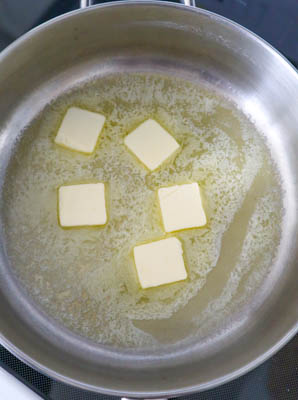
Melt the butter in a skillet.
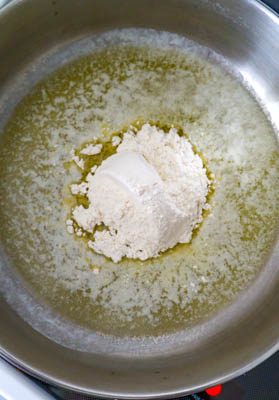
When the butter is melted add the flour and start mixing it in. The flour is cooking in the butter. Stir continuously. The roux is going to start getting thick right away.
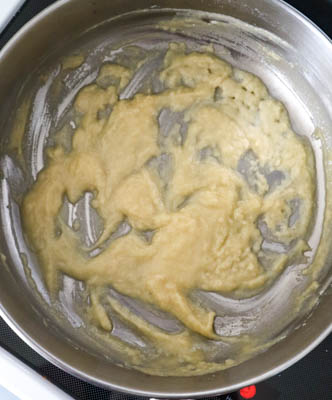
Here is our roux when it is done. The flour and butter are fully incorporated. It’s a yellowish paste.
You can tell how thick it is by looking at the picture. Get your roux off the burner while it is still yellow. If left on too long it will start to brown. Sometimes you want that, but not for a white sauce like we are making here.
As you are stirring you can actually smell the flour cooking. The raw flour morphs into this golden buttery smelling paste.
There are home cooks that tell me they just can’t master making a roux. Here’s the key: Continue to stir, stir, stir. You cannot leave it alone. It only takes minutes but you have to watch and stir continuously. And when it is fully cooked, get it off the heat.
Making your roux into a sauce
Now we are going to add our salmon broth to the roux to make a thick and creamy lump free sauce.
You can’t just pour all the broth in at once. You have to pour the broth in slowly, especially at first. As you start adding it, the broth is going to quickly get absorbed by the flour. Stir continuously as you are adding the liquid. Add more when the liquid you added is fully incorporated, creamy and smooth. You need to add about a third of it at a time. When adding the first third it’s critical that you are adding it very slowly. This is the point where lumps can occur. Adding the second third will go a little easier and the last of the broth will be easy to incorporate. Every time you add broth make sure the sauce is thickening. lump free and creamy before you add more.
The 4 cups of broth I had was perfect for the amount of flour and butter in the roux. If you have less than 4 cups you may need to add some water. That’s perfectly okay.
Once again, the key to success is time and patience along with stir, stir, stir.
This step isn’t going to take much longer than making the roux. It only takes a few minutes.
Here’s what turning roux to sauce looks like

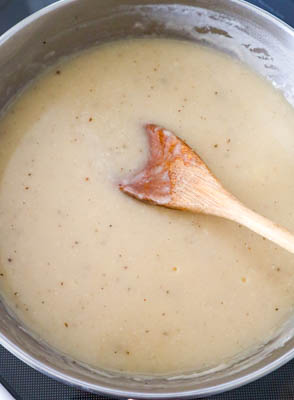
Add the salmon and peas
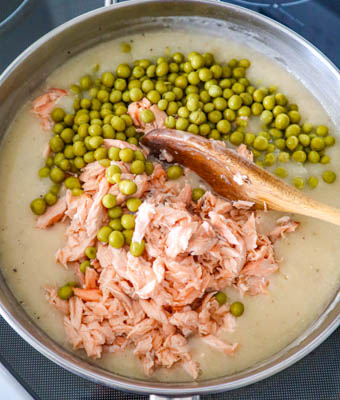
Add the flaked salmon and peas to the white sauce.
Gently mix it all together and let it cook for about 10 minutes on medium heat or lower to warm everything up and blend the flavors. Don’t use high heat and don’t let it boil.
Serve over toast, crackers, potatoes or noodles
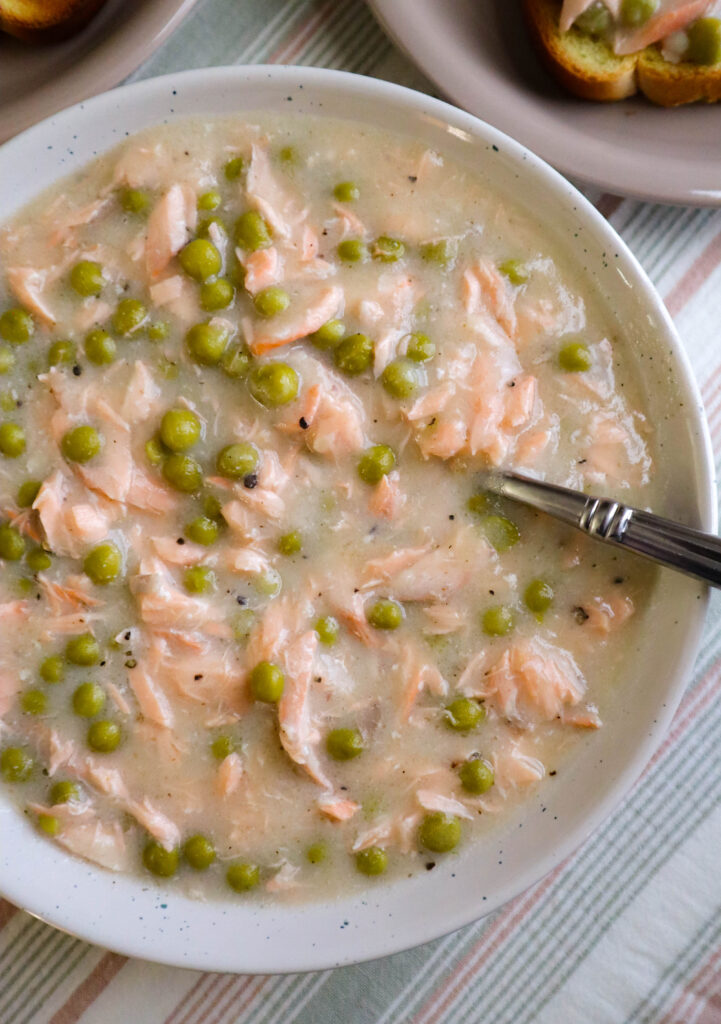
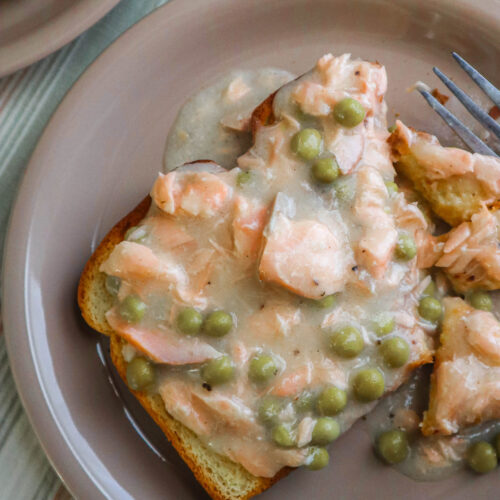
SALMON and PEAS
Ingredients
- 1½ pounds salmon
- 1 small yellow onion
- 5 tablespoons butter
- 1/3 cup flour
- 1 teaspoon salt
- 1 teaspoon pepper
- 1 can peas 14.5 ounce can or 1 ⅓ cup frozen peas
Instructions
Poaching the Salmon
- Put the salmon, skin side down in a skillet. Add enough water to cover the salmon.
- Cut a small yellow onion in quarters and add it to the water.
- Poach the fish in a warm water bath until it splits open and is cooked through. It will turn a lot lighter in color. It should take about 15 minutes.
- If you are not familiar with poaching, which is slowly cooking in a hot water bath, we have a lot more on that with pictures in the post.
- Remove the fish with a spatula and put it on a plate. Strain the poaching water into a bowl or large measuring cup. Straining will get the onion out and some of the white fish residue in the water. You will have about 4 cups. We are going to use the broth to make the cream sauce. If you didn't get 4 cups of broth supplement with water.
- With two forks, flake the salmon off the skin and set it aside. You can throw the skin away.
Making a Roux
- After cleaning the skillet used for poaching, melt the butter in the skillet over medium heat.
- When the butter is melted add the flour and start stirring them together with a wooden spoon. Stir constantly until the butter and flour are completely incorporated and you have a thick buttery paste. We have more on making the roux in our post.
Making the white sauce
- This is called a cream sauce but it has no dairy in it, It is actually a white sauce.
- Slowly add the salmon poaching broth to the roux. Use only ⅓ of the liquid each time you add it to the roux and fully incorporate it before adding the next ⅓ and the final ⅓. Add the salt and pepper. Stir constantly. This is how you will get a smooth delicious buttery sauce.
Add salmon and peas
- Add the salmon and peas to the cream sauce and continue to cook on low to medium heat for about 10 minutes until salmon and peas are up to temperature and the flavors are incorporated. Don't let the sauce boil.

